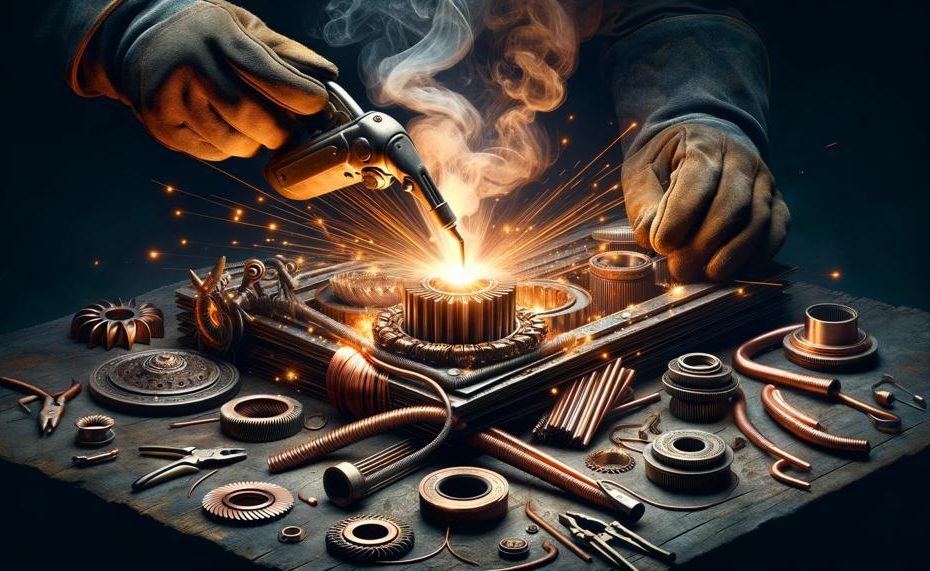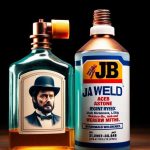Welcome to the fascinating world of welding, a process that not only binds materials together but also serves as the backbone of countless industries, from automotive manufacturing to construction. At the heart of this indispensable technique lies the choice of metals, each with its unique properties, challenges, and applications. Welding isn’t a one-size-fits-all scenario; it’s an art that requires understanding the distinct characteristics of different metals to achieve the best results. This blog post dives deep into the world of weldable metals, shedding light on why some metals are more conducive to welding than others, and how this knowledge can be applied to create structures and products that are both durable and reliable.
So, which metals can be welded and why?
You can weld a wide range of metals, such as:
- Aluminum is a common material due to its excellent conductivity, corrosion resistance, and lightweight nature. For aluminum, TIG welding is the recommended technique.
- Stainless steel: A well-liked option due to its strength and resistance to corrosion. To weld stainless steel, arc welding is used.
- Copper: A well-liked material because to its wear durability, corrosion resistance, electrical and thermal conductivity, and aesthetic appeal.
- Steel: Steel is a common material since it’s easily accessible and reasonably priced. It may, however, flake and corrode.
- Cast iron: Cast iron is another common material, but in order to keep it from splitting, it has to be heated first.
Magnesium, brass, and bronze are some more metals that are weldable.
It is essential to comprehend the properties of various base metals in order to perform good MIG welding. Copper, for instance, is delicate and has to be handled carefully, while nickel alloys are used in high-temperature applications using certain methods.
Let’s get started.
Contents
- 1 Types of Metals That Can Be Welded
- 2 Properties of Metals That Affect the Welding Process
- 3 Steel – Most Commonly Welded Metal
- 4 Stainless Steel – Corrosion-Resistant Properties
- 5 Aluminum – Lightweight and Versatile
- 6 Copper and Brass – Low Melting Points
- 7 Steel – Most Commonly Welded Metal
- 8 Stainless Steel – Corrosion-Resistant Properties
- 9 Aluminum – Lightweight and Versatile
- 10 Copper and Brass – Low Melting Points
- 11 Conclusion
Types of Metals That Can Be Welded
In the realm of welding, certain metals stand out for their compatibility and are frequently chosen due to their unique characteristics, making them particularly suitable for joining and repairing.
Below, we delve into the specifics of these metals.
| Metal | Key Characteristics | Preferred Welding Techniques |
| Steel | Strong, versatile, corrosion-resistant | MIG, TIG |
| Stainless Steel | Exceptional corrosion resistance | TIG |
| Aluminum | Lightweight, strong, high thermal conductivity | TIG, MIG |
| Copper | Highly conductive, heat sensitive | Controlled temperature techniques |
| Nickel Alloys | Withstands high temperatures, versatile | Varied, adaptable to different methods |
Each of these metals brings its own set of benefits to the welding table, shaped by their physical and chemical properties. The right choice of welding technique enhances these intrinsic qualities, ensuring a solid, lasting bond.
Whether you’re patching up a broken tool or crafting a new piece, understanding these metals and their suitable welding approaches will pave the way for successful projects.
Properties of Metals That Affect the Welding Process
Welding, at its core, is about melting and fusing metals. Not just any hodgepodge of metals, mind you, but ones selected for their specific traits that make them mates in this heated dance.
Melting Point: A Dance of Heat
Imagine you’ve got two metals. One’s a softie, melting at the mere suggestion of heat, while the other’s a tough cookie, requiring a blast furnace’s embrace to liquify.
Aluminum, for instance, melts at a relatively cool 660°C, making it a darling in the welding world.
On the flip side, stainless steel plays hard to get, with a melting point hovering around 1400-1450°C, necessitating not just more heat but a refined technique to join the dance.
Ductility: The Art of Bending without Breaking
Ductility’s all about flexibility; it’s a metal’s willingness to be pulled and stretched into new shapes without throwing a tantrum (read: breaking). Copper and gold, being the gymnasts of the metal world, excel here, allowing welders to craft intricate designs with ease.
Cast iron, though, is the stiff one at the party, cracking under the pressure of being bent into new shapes, making it a challenge to weld without the right know-how.
Steel – Most Commonly Welded Metal
Steel stands out as the most commonly welded metal, a testament to its unparalleled attributes in the realm of construction, manufacturing, and beyond.
Its appeal in welding circles boils down to several key advantages, making it a go-to material for projects demanding strength, durability, and flexibility.
| Property | Advantage | Implication in Welding |
| High Tensile Strength | Withstands high stress | Enables the creation of sturdy, long-lasting structures |
| Versatility | Customizable to project needs | Allows for specific welding approaches tailored to the steel type |
| Corrosion Resistance | Longevity in harsh conditions | Essential for projects exposed to the elements or corrosive substances |
| Weldability | Ease of joining | Diverse welding techniques can be applied, enhancing project flexibility |
| Economic Efficiency | Cost-effective over time | Makes it a preferred choice for budget-conscious projects without compromising quality |
The mastery of welding steel is not just about the technical know-how but also an intimate understanding of its intrinsic qualities.
Stainless Steel – Corrosion-Resistant Properties
Stainless steel stands out in the realm of metals for its remarkable resistance to corrosion, a characteristic that is indispensable for welding applications. This resilience is chiefly due to its high chromium content, which, when exposed to oxygen, forms a sturdy oxide layer on the metal’s surface.
This layer is incredibly effective at shielding the underlying metal from various forms of corrosion and environmental wear.
Such a feature makes stainless steel an ideal candidate for projects that demand longevity and durability, especially in environments prone to corrosive agents.
The Core of Stainless Steel’s Resistance:
- Chromium Content: Stainless steel owes its corrosion-resistant properties to the presence of chromium. At least 10.5% of this metal is chromium, which reacts with oxygen to create a protective oxide layer.
- Oxide Layer: This layer acts as a shield that blocks corrosive substances from reaching the metal’s core, thus preserving the steel’s structural integrity and appearance.
Why It’s A Welder’s Ally:
Welding, by its nature, subjects metals to extreme temperatures that can compromise their structural integrity. Stainless steel, however, maintains its corrosion resistance even after welding, thanks to the self-repairing nature of its oxide layer. This makes it a reliable choice for constructing everything from architectural features to kitchenware and industrial machinery.
Challenges and Solutions in Welding Stainless Steel:
Although stainless steel is highly corrosion-resistant, selecting the right type for a specific environment is crucial.
Its various formulations, which include differing amounts of chromium, nickel, molybdenum, and other elements, are designed to withstand different corrosive agents and temperatures.
| Type | Chromium Content | Suitable Environments |
| Austenitic | 16-26% | Most versatile; good for a wide range of environments |
| Ferritic | 10.5-30% | Good resistance to cracking; suitable for indoor applications |
| Martensitic | 12-14% | Higher strength; best for environments requiring durability |
Welding stainless steel isn’t just about joining metal; it’s about preserving the metal’s intrinsic properties while ensuring that the finished product can withstand the tests of time and environment.
Proper design, fabrication, and maintenance can further enhance the corrosion-resistant qualities of stainless steel weldments, ensuring their performance in a variety of conditions.
Aluminum – Lightweight and Versatile
Aluminum shines as a favoured contender in the welding arena, revered for its trifecta of being lightweight, resilient against the elements, and a whiz at conducting both heat and electricity. Diving into the nitty-gritty, it’s the remarkable strength-to-weight ratio that steals the limelight, making aluminum the go-to for industries where keeping things light yet sturdy is the name of the game – think aviation marvels and sleek automobiles.
But it’s not just about being a featherweight champion; aluminum’s knack for warding off rust is a tale worth telling. This metal doesn’t flinch in the face of corrosion, thanks to its self-protecting prowess. When it meets the air, it forms a tough-as-nails oxide film, like an invisible shield, that keeps the rust at bay. And when it comes to getting the heat through or keeping the electrical current flowing, aluminum’s your trusty ally.
Here’s a peek into the details that make aluminum welding a craft:
| Property | Benefit | Consideration |
| Strength-to-weight ratio | Lightweight yet sturdy structures | Requires precision in heat management |
| Corrosion resistance | Longevity in harsh conditions | Surface preparation to maintain integrity |
| Thermal and electrical conductivity | Efficient in heat and electrical applications | Demands control over welding parameters |

Copper and Brass – Low Melting Points
Copper and brass shine as quintessential choices for welding, chiefly owing to their lower melting points. This pivotal characteristic makes them exceptionally malleable, permitting welders to fuse them with less energy and finer control, avoiding the degradation of the metal’s intrinsic properties.
Key Traits of Copper and Brass in Welding:
- Lower Melting Points: A boon for welders, as it allows for quicker, more efficient welding processes, ensuring that these metals can be joined without the complications associated with higher-melting-point metals.
- Superior Conductivity: Both metals conduct heat and electricity with aplomb, a trait that necessitates adept temperature management during the welding process to prevent warping or unwanted alterations in the metal’s structure.
- Versatility: Their application spans myriad industries, from electrical components to artistic sculptures, showcasing their adaptability in both functional and aesthetic capacities.
- Corrosion Resistance: Especially brass, which boasts an added resistance to corrosion, making it ideal for use in environments where this could be a concern.
Comparing Melting Points:
| Metal | Melting Point (°C) | Remarks |
| Copper | ~1,085 | Low, manageable for welding |
| Brass | 900-940 | Varies with composition; generally low |
| Steel | ~1,370-1,540 | Higher, more challenging to weld |
Steel – Most Commonly Welded Metal
Steel stands as the linchpin of the welding world, its popularity underpinned by a blend of strength, adaptability, and a staunch stand against corrosion.
Dive a tad deeper, and you’ll uncover the crux of why this alloy takes the crown in the welding realm.
| Characteristic | Benefit in Welding | Comparison |
| High Tensile Strength | Endows structures with resilience and longevity. | Outstrips materials like aluminum in load-bearing capability. |
| Versatility | Adapts to a spectrum of welding methods and applications. | More accommodating than metals like copper, which demand precise temperature control. |
| Corrosion Resistance | Steel variants like stainless steel offer robustness in harsh environments. | Surpasses standard metals in durability, particularly in corrosive settings. |
Beyond its inherent merits, steel’s widespread use in industries from construction to automotive manufacturing amplifies its prominence in welding circles. Each sector relies on steel’s reliability to forge structures and components that stand the test of time and the elements.
While other metals like aluminum and copper boast their unique advantages, such as lightweight and superior conductivity respectively, steel’s balanced portfolio of properties makes it the go-to choice for welders aiming for enduring results. Moreover, the evolution of welding techniques tailored to steel’s nuances ensures that this venerable metal remains at the forefront of welding innovation.
Stainless Steel – Corrosion-Resistant Properties
Stainless steel stands as a titan in the realm of welding, its appeal rooted deeply in its unique amalgamation of traits that ensure it remains unrivalled by ordinary steel varieties. The essence of its popularity for welding tasks and its inherent resistance to the ravages of corrosion are woven into the very fabric of its structure, a testament to the ingenuity of materials science.
Key Attributes Making Stainless Steel Ideal for Welding
- Resilience Under Heat: The formidable resilience stainless steel exhibits against the intense heat of welding operations stems from its composition. This alloy, with its significant chromium content, does not falter under the high temperatures, maintaining its structural integrity and mechanical properties.
- Versatile Welding Compatibility: This material’s adaptability across various welding techniques, including MIG, TIG, and stick welding, is nothing short of remarkable. Its versatility extends to its ability to meld strength with ductility, making it suitable for a broad spectrum of welding projects.
The Shield Against Corrosion
| Element | Role | Benefit |
| Chromium (Min. 10.5%) | Forms chromium oxide layer | Creates an invisible, protective barrier against moisture, preventing rust. |
| Nickel, Molybdenum, Nitrogen | Enhances structure | Boosts the alloy’s stability, improving corrosion resistance in various environments. |
| Varied Grades (e.g., 304, 316, 410) | Specific applications | Offers options for optimal performance based on environmental exposure. |
The crux of stainless steel’s corrosion resistance lies in its ability to spontaneously form a thin, yet robust, layer of chromium oxide. This layer, invisible to the naked eye, acts as a steadfast guardian against corrosion, sealing the alloy from aggressive elements that seek to degrade it.
The presence of other elements such as nickel, molybdenum, and nitrogen fortifies this barrier, enhancing its resistance to both oxidation and reduction, even in the harshest of environments.
Aluminum – Lightweight and Versatile
Aluminium stands out in the world of welding due to its unique blend of lightness and strength. This metal’s versatility is anchored in its significant applications across diverse industries – from soaring aircraft frames to sleek automotive components.
Why Aluminium Shines in Welding:
- Thermal Conductivity and Melting Point: While its impressive thermal conductivity challenges welders by requiring higher energy inputs, this very property ensures swift heat dissipation, reducing the risk of warping in thin materials.
- Oxide Layer Challenges: Despite the oxide layer’s knack for complicating welding by necessitating its removal pre-weld, this same layer gifts aluminium its much-valued corrosion resistance – a trait highly prized in harsh or marine environments.
- Techniques Tailored for Aluminium: Welders harness specific techniques, such as TIG (Tungsten Inert Gas) and MIG (Metal Inert Gas) welding, to conquer aluminium’s unique challenges. These methods afford precision and control, making them well-suited to aluminium’s characteristics.
- Versatility and Industry Use: Its application in sectors as varied as aerospace, automotive, and construction speaks to aluminium’s adaptability. This metal, embodying both sturdiness and ductility, proves indispensable where weight reduction is critical without compromising structural integrity.
- Innovation and Improvement: Advances in welding technology continuously enhance the efficacy of joining aluminium parts, promoting stronger, more reliable structures.
Aluminium’s Lightweight and Versatile Attributes:
| Attribute | Significance | Industry Impact |
| Low Density | Facilitates ease of handling and increased fuel efficiency | Aerospace, Automotive |
| Corrosion Resistance | Extends lifespan and maintains structural integrity | Construction, Marine |
| Recyclability | Promotes environmental sustainability | Consumer Goods, Packaging |
Copper and Brass – Low Melting Points
Ease of Welding
Copper and brass, with their lower melting points, simplify the welding process.
These metals require less heat and energy, reducing the likelihood of errors and imperfections. It’s akin to gently simmering a stew, ensuring the flavours meld perfectly without scorching.
| Feature | Copper | Brass |
| Melting Point | Lower than many metals | Similar to copper |
| Thermal Conductivity | High, requires skill | High, with zinc control |
| Application | Electrical, plumbing | Decorative, functional |
Durability and Corrosion Resistance
Despite their ease of melting, copper and brass are tough cookies.
They resist corrosion like a sturdy ship braves the sea, making them excellent for long-lasting applications in plumbing and electrical work.
Skillful Handling
Welding these metals isn’t a walk in the park. It demands finesse – like balancing spices in a recipe.
Copper’s high thermal conductivity necessitates skillful heat management, while brass requires vigilant temperature control to prevent zinc evaporation.
Versatility
Their low melting points don’t compromise their usefulness. Brass and copper play vital roles in a range of applications, standing tall in both functional and decorative roles.
They’re like versatile actors, adept in both dramatic and comedic roles.
Eco-Friendly Options
In today’s world, where green is gold, the recyclability of copper and brass shines bright. They’re not just useful in their first act; they can be reborn, playing new roles in various applications.
Understanding these metals is crucial, akin to knowing the secret ingredients in a family recipe.
Conclusion
To sum up, the field of welding offers a plethora of opportunities by working with different metals, each having special qualities and uses.
Welding takes advantage of the inherent properties of various materials, such as the high-temperature endurance of nickel alloys, the lightweight flexibility of aluminum, the conductive power of copper and brass, and the unwavering resilience of steel and stainless steel, to create parts and structures that are essential to our daily lives and the businesses that drive our economy.
Understanding these metals’ melting points, ductility, electrical and thermal conductivity, and corrosion resistance is essential to efficient welding.
By delving into the subtleties of each metal’s welding compatibility, we open the door to technological, building, and transportation advancements, demonstrating that the craft of welding is about more than simply combining metals—it’s about influencing the course of history.





